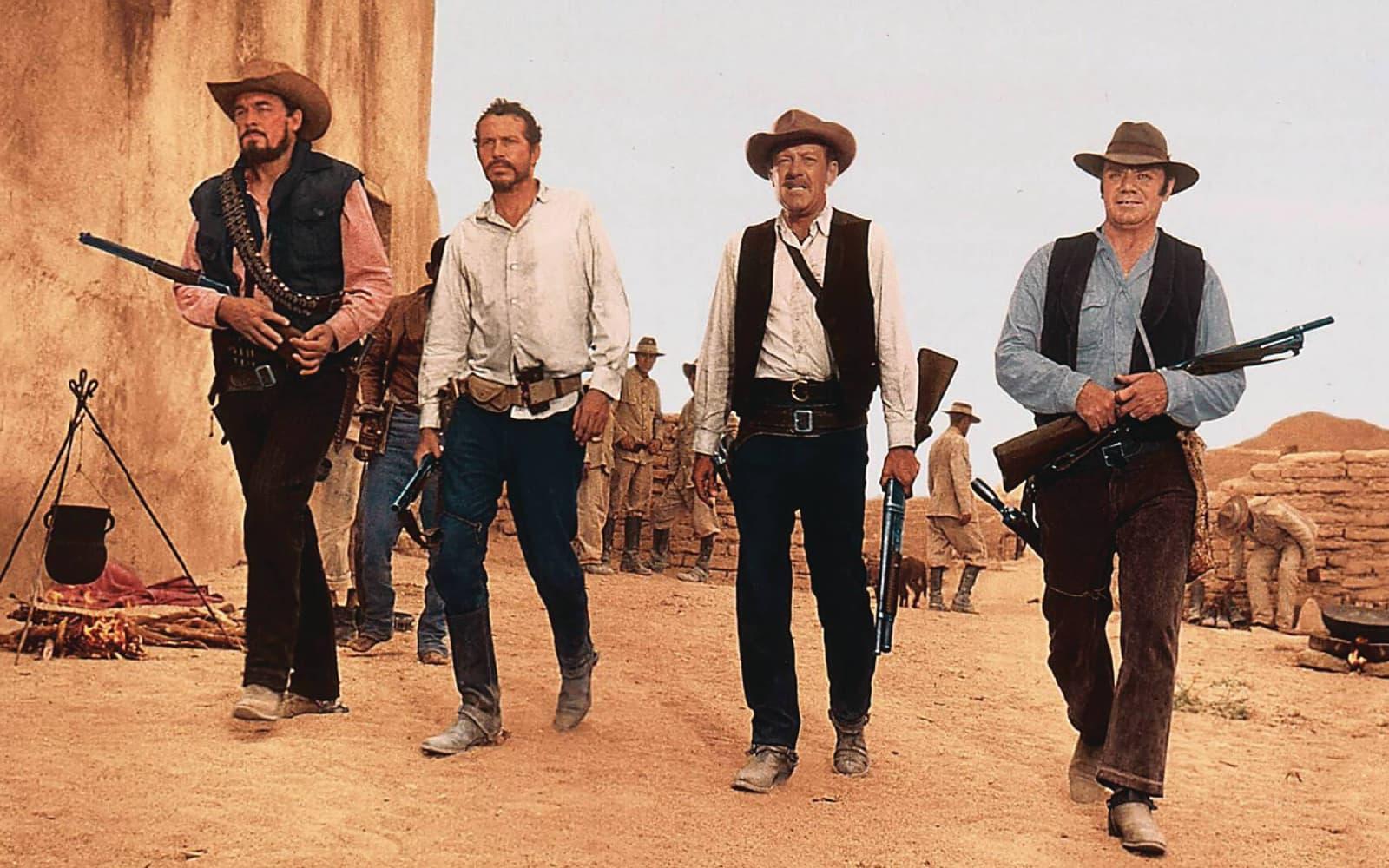The Wild Bunch by Sam Peckinpah (Review)

There’s no topic quite like violence in the media. Just mentioning it is like lighting a fuse. Before you know it, you’ve got a full-bore debate on your hands, complete with moral outrage and indignation on one hand and free speech advocacy on the other. And this debate always seems to reach its culmination with violence in movies; as soon as election time rolls around, you’re bound to see some windbag calling for Hollywood to act responsibly and tone down its content. But what people seem to forget is that violence does not have to equate with thrills and action. And a movie as brutal and bloodthirsty as The Wild Bunch makes a convincing argument.
It’s impossible to read anything about The Wild Bunch without its violence quickly becoming the focus. Directed by Sam Peckinpah (who made a career out of violent, disturbing films), The Wild Bunch does not shy away from its subject matter. Indeed, there are times where it even seems to revel in it.
Over 10,000 squibs (fake bullets) were used in the final shootout, and it’s rumored that more blanks were discharged during filming than real bullets fired in the Mexican Revolution. When filming bullet wounds, Peckinpah would use two squibs, one for the bullet’s entry and one for its exit; the result were literal explosions of blood, filmed in slow motion and rapidly intercut with other scenes of mayhem.
At times, it reaches John Woo levels (which makes sense, since The Wild Bunch is one of Woo’s favorite films). But for all of its carnage, the movie never glamorizes it. Don’t get me wrong, it is action-packed and a blast to watch. I doubt there are many movies as hardcore and exciting as The Wild Bunch. But we’re not talking about a Schwarzeneggar or Stallone movie here.
Just when it seems like the movie might be glorying in its carnage, Peckinpah smacks you upside the head with the consequences of his movie’s violence. In the movie’s first 15 minutes, half a town is massacred in a gunfight between a gang of bank robbers and the very men sent to capture them. It immediately makes you wonder just where the lines are drawn, if the heroes are actually as bad as the villains, and if there really are any heroes to begin with.
The thieves, led by Pike Bishop, intend for this to be their last heist. They’re getting old and tired, and hope to disappear. But when they discover that their latest robbery was a bust, they realize they’re not done yet. Meanwhile, one of Pike’s former henchmen has been coerced to track him down with a bunch of greedy, violent bountyhunters. With the posse on their trail and nothing to show for their labor, the bunch gets involved in a Mexican civil war. Hired to steal a cache of weapons for the U.S. military, Bishop’s men pull it off and stay one step ahead of the posse, only to face more betrayal.
What really makes the violence in The Wild Bunch so disturbing and provocative is how pervasive it is. Noone is innocent, not even children. One of the first scenes we see is that of a group of children circled around a scorpion being consumed by ants; as the camera closes in on the horrific scene, we hear the children’s innocent laughter. Later, we see children reenact a gunfight just minutes after its conclusion, shooting each other with imaginary guns amidst the bullet-riddled bodies.
Pike and his gang are never portrayed or built up as anything other than vile men, and even when they experience a moment of peace, they know they can never be anything else. But even then, they have one redeeming characteristic; their honor. During one powerful exchange, Pike yells at his men “When you side with a man, you stay with him. And if you can’t do that, you’re like some animal, you’re finished.” It sounds odd coming from a man who can casually kill innocent bystanders, but you also realize that this sense of personal honor is all he has, and he clings to it with desperation.
When Mapache arrests one of their own, the others head back to rescue him. As Pike collects his men for one last escapade, very little is said. Nothing has to be said. Each knows they’re going to die, but they’re going to die like men. Their final walk, echoed in movies ranging from Reservoir Dogs to Swingers, is one of the toughest, most bad-assed moments in cinema. You know these men are staring death in the face, but their grim determination to make a stand for the little that they know is right is beautifully captured.
It’s hard to get caught up in the thrills that The Wild Bunch offers without also getting caught up in the characters. You sympathize with Pike. The world he once knew is changing (beautifully demonstrated when the gang comes across Mapache’s car), but he lashes out the only way he knows how. You laugh with them, and it’s easy to forget that they’re bloodthirsty outlaws at times. But we’re never allowed the luxury of romanticizing them. They do some horrible deeds, and at the same time, you also realize that the world around them is just as bloodthirsty.
It’s that age-old argument; is it the world’s violence that corrupts man, or does man’s violence corrupt the world? In The Wild Bunch, it’s a cycle. Violence begets violence (poignantly proven with the children in the opening scenes). And noone seems more violent than Pike and his men. But in the final moments, it’s their code of honor that lets them use that violence for one final, noble purpose. And even though their end is, perhaps justifiably, brutal and gory, it’s also their one chance for redemption… as bloody as it might be.
